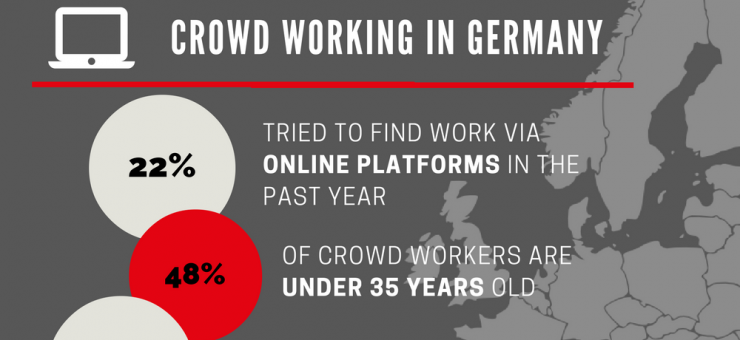Digital Footprint study results from Germany confirm once more that working in the gig economy has become a new reality for many

Research by the University of Hertfordshire and Ipsos MORI, in association with the Foundation for European Progressive Studies (FEPS), UNI Europa, ver.di, and IG Metall has revealed the true size of the German ‘gig economy’. It confirms once more that working in the gig economy has become a reality for many people today.
22% of survey respondents in Germany have tried to find work via online platforms during the past year
4% of respondents said they have managed to find work in this way at least once a week
17% of crowd workers are over 55, compared with 20% who are under 24 years old – the majority are in the 25-35 age group
The study shows an overall attitude shift: crowd workers do not, or cannot, restrict themselves to a single type of work but offer to provide several kinds of service, with an extremely broad range, from high-skill professional work at one extreme, to running errands at the other. The overall picture emerging is of a new group of workers trying to piece together a livelihood from a range of different tasks.
Oliver Roethig, Regional Secretary of UNI Europa said: ‘Once more, these results confirm the rise of the gig or platform economy everywhere in Europe, producing a variety of challenges in regards to workers’ rights, undeclared and precarious work, taxation, pension and health and safety. Formal employment relationships are fading and platforms transform colleagues into competitors – perfect conditions for anti-union businesses! That is where the EU must come in: we need inclusive European legal frameworks to ensure fair and equal treatment of, and security for all workers, be it in traditional or new forms of employment. And we need to ensure their right to unionise and collectively bargain.’
22% of respondents in the online survey say they have tried to find work via online ‘gig economy’ platforms such as Upwork, Uber or Handy during the past year – with 14% of respondents succeeding in doing so. Of these, 18% said they earn at least half (but not all) of their income from such platforms, but 2% said they earn all of their income this way.
Men are slightly more likely than women to work in this way and crowd workers have a small tendency to be younger than average. Their income is generally modest, with 40% of crowd workers earning less than €18,000 a year.
The 25-35 age group once more represents the biggest share of the German crowd workforce. FEPS Senior Economist Catalin Dragomirescu-Gaina noted that ‘the age distribution of crowd workers is generally tilted towards individuals under 35, the so-called ‘millennials’ generation, whose propensity to engage in online activities is well recognised; hopefully, this will add pressure to modernise public services (like broadening access to e-government services), and improve policies that address their evolving needs.’
Ursula Huws, Professor of Labour and Globalisation at the University of Hertfordshire commented, ‘These findings show that Germany is following a very similar path to the UK, Netherlands, Sweden and Austria in these new employment patterns. Last week’s ruling in the UK that Uber drivers should be treated as workers entitled to the minimum wage, drew attention to the need to bring gig economy workers within the scope of formal regulations right across the EU’.
Read the full survey results here
Note to editors
University of Hertfordshire, European think tank FEPS and European service workers’ union UNI Europa are collaborating on a year-long research project to explore the scale and impact of the growth of crowd working, and provide a more comprehensive picture of the digitalised labour market across the European Union.
Results have been published so far on the United Kingdom, Sweden, the Netherlands and Austria.
The German survey was co-sponsored by ver.di and IG Metall. In Germany, 2180 adults aged 16-70 were interviewed. Interviews took place between 1-4 April 2016. Data are weighed by age within gender, region, working status, population density of respondent settlement, chief income earner of the household and household size to match the profile of the adult population aged 16-70 in Germany.

